What the ... ?
I thought I could make a joke about mines or miners as the starter for today’s newsletter. Nope, drawing a blank …
So I went online to see if there are any good jokes or puns about miners I can plagiarize ... ahem ... draw inspiration from. There are plenty on the websites I visited, but none really made me laugh. Puns such as, “Why does a miner go back to school? To get his masters in digging,” and “A gold digger walks into a bar …” just don’t cut it for me.
I guess I simply don’t understand the life of a miner. Other than a few open-air mines and quarries I saw from the sky and tourist-filled caves I’ve visited, I have near-zero experience with a mine. I don’t have an appreciation of what it’s like to be a miner. I’m more suited for a life above ground.
There are bugs that attain security by enclosing themselves within a mine. Borers are the ultimate miners of tree trunks. Leafminers are also the masters of creating mines of many shapes and sizes between the epidermis of leaves. Summer is a great time to see these leaf mines, such as those on an aspen leaf shared with me by Tim Boyle and those on a mallow leaf I saw in California.
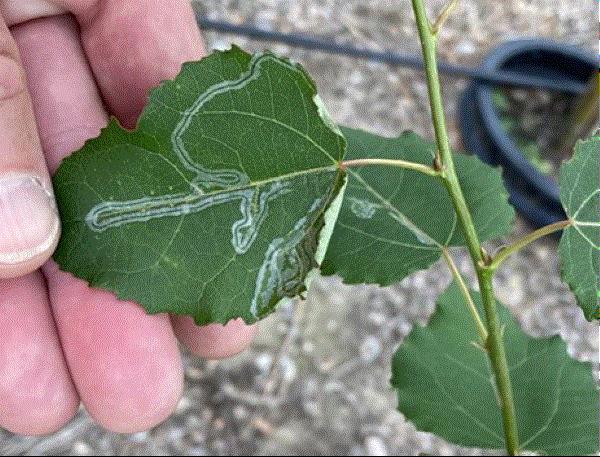
A mine on an aspen leaf. (Photo credit: Tim Boyle, Wisconsin Department of Agriculture, Trade and Consumer Protection.)
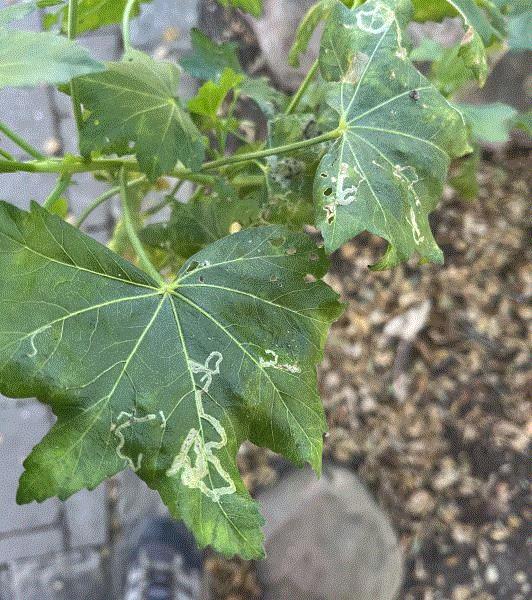
Mines and symptoms of viral infection on mallow leaves.
My graduate school advisor, Dr. Ron Oetting of the University of Georgia (who recently passed away), remembered the years of battling leafminers on mums and (later on) gerbera daisies. He credited these battles as moments when the messages of pesticide resistance management and biological control were most well received. This summer, you’ll also find mines on your favorite birch, elm, oak, citrus, holly, columbine, boxwood, tomato, etc.
These leafminers are often inconspicuous and mind their own mining business. But their diversity and potential for damage certainly makes them stars in their own right, so I’m going to dedicate today’s newsletter to them and let them shine a little. (A joke about diamond in the rough ...? Nope, it's still not coming to me ...)

Kinds of Leafminers
A leafminer may be a species of moth, wasp (more specifically a sawfly), fly or beetle. A member from another insect order may also mine between leaf surfaces, but the four orders above take up the vast majority of the leafmining kinds. Often, the leafmining stage is the larval stage of these species.
Each species creates a mine of specific shape, size or appearance on specific host species. If you’d committed to your memory the relationship between host and mine appearance, you can often identify the leafminer species or groups in the field.
For example, a columbine leafminer (a fly) creates a serpentine mine on columbine and a boxwood leafminer (also a fly) creates a yellowish blotch mine on boxwood. Aspen leafminer (a moth) creates a serpentine mine on aspen (see Tim’s picture above). Even the tiny pine needles can be attacked by a group of tiny leafmining moths, collectively called the needleminers.
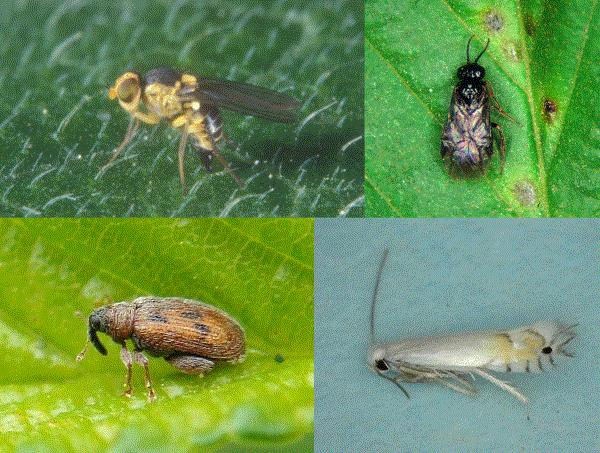
The majority of leafminer species come from four orders (clockwise)—flies (the American serpentine leafminer in the picture); sawflies (elm leafminer); moths (aspen leafminer); and beetles (European elm flea weevil). (Photo credit: Lyle Buss, University of Florida; Whitney Cranshaw, Colorado State University; Michael Palmer, bugguide.net; Yurika Alexander, bugguide.net.)
Some leafminer species attack multiple host species. For example, the American serpentine leafminer was the bane of mum growers’ existence in the 1980s. They also attack eggplant, celery, gerbera daisy, marigold and more than 50 other species.
Some plant groups are attacked by multiple leafminer species. Elm leaves are regularly disfigured by elm leafminers, which are sawflies that create blotch mines that eventually consume the entire leaves. Elm trees with Siberian and Chinese elm parentage are attacked by European elm flea weevil in some parts of this country. Although the name sounds like a flea beetle, the European elm flea weevil is in fact a leafminer that creates blotch mines on elm leaves.

Managing Leafminers
We can’t always avoid leafminers, so what can we do about it?
For most gardeners and arborists, my first suggestion is to take a deep breath and chill. Although the damage can look alarming, a well-established or mature tree or shrub can withstand some mines. The loss of leaf tissue to leafminers is miniscule when you consider the amounts of leaves that are still functional and photosynthetic. Insecticide treatment is only needed when the trees are severely defoliated.
My second suggestion is not to reach for the nearest insecticide. Most leafminer populations (even those invasive ones) are suppressed by many natural enemies, ranging from spiders to tiny parasitic wasps. The worse thing we can do is to spray some broad-spectrum insecticide and end up killing the natural enemies. Without suppression from their natural enemies, the leafminer populations will explode.
Insecticides should be reserved for plant production or when dealing with invasive or particularly damaging native leafminer species. You can spray a contact or translaminar insecticide or drench a systemic insecticide at the right time. I wrote about managing boxwood leafminer in this newsletter (back in 2019). The same approach for boxwood leafminer could be used for most leafminer species.
Briefly, y’all need to understand the life cycle of the particular species you’re dealing with because you want to drench before the larvae begin to feed and to spray when the adults are flying or the larvae are feeding. For boxwood leafminer, systemic insecticides are best applied in the fall or the spring, and contact and translaminar insecticides are best applied when adults are flying in the spring. Treatment efficacy is often lower if you missed the window of treatment. Go HERE to read my piece on managing boxwood leafminer.
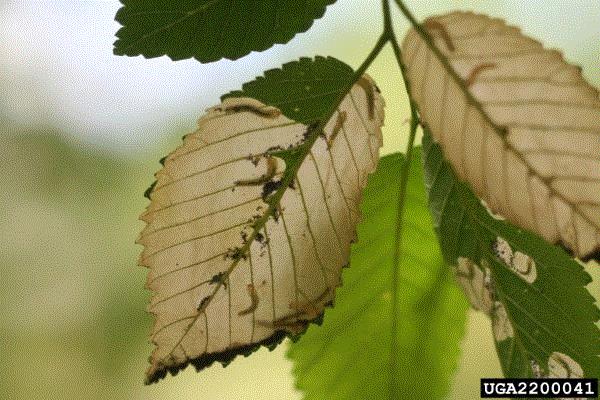
This Siberian elm leaf was almost completely consumed by elm leafminers. It looks scary, but losing a few leaves may not be that big of a deal for a mature elm tree. It’s only when infestation is severe that management is needed. (Photo credit: Whitney Cranshaw, Colorado State University, Bugwood.org.)
For greenhouses and nurseries, leafminers are considered occasional pests these days. When management is needed, I've seen pretty good efficacy with a program that includes abamectin, acetamiprid, cyromazine, novaluron, dinotefuran (same mode of action as acetamiprid) and (when absolutely necessary) acephate. Other insecticides, such as chlorantraniliprole and flupyradifurone, may also be included in a rotation program. Insecticide rotation is essential (we learned our lessons in the 1980s and 1990s, so we don’t need to relearn that lesson).
The same principle of not messing up biological control on landscape trees and shrubs with insecticide spray, known as conservation biological control, is also applicable to greenhouses and nurseries. Biological control agents, such as the parasitic wasps Diglyphus isaea and Dacnusa sibirica, may be available for purchase and release in greenhouses and nurseries. Check with your suppliers for availability; not every insectary keeps up with the production of these parasitic wasps because of the “minor” pest status of leafminers these days.
Just like many other pests, leafminers get into a production area from an outside source via infested plant material or adults flying in from surrounding fields (particularly vegetable fields). Go HERE and HERE on exclusion and other pest management practices against leafminers. Go HERE for an article on using silicon in leafminer management. These are older articles, but the lessons remain the same today.

Paul Pilon Talks Sprayers
I want to close today’s newsletter with an important message from Paul Pilon: It’s important to properly maintain your spray equipment. This is a principle I subscribe to. It’s not only applicable to growers and pest managers, but to anyone who ever sprayed or is going to spray a pesticide.
The “why” is pretty simple. As Paul explains in his column in the June issue of GrowerTalks, a poorly maintained sprayer doesn’t achieve proper coverage or the right amounts of pesticides, which then leads to inadequate control and potential phytotoxicity. To avoid all these problems, Paul suggests that you keep your spray equipment clean, check the filters and nozzles, maintain the equipment regularly (instead of waiting until it fails to have a look), and calibrate. (Calibrate and calibrate!)
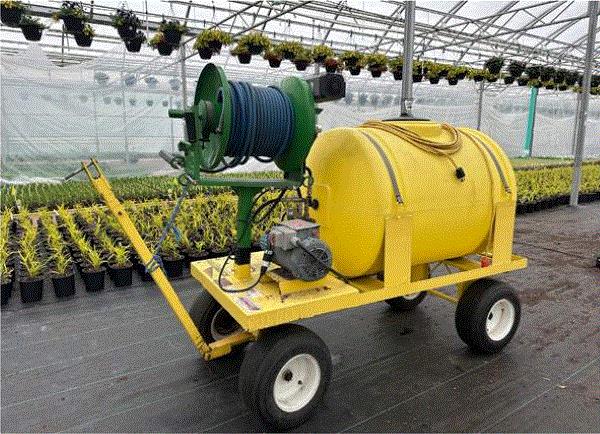
"Don't underestimate the importance of maintaining your spray equipment," said Paul Pilon. (Source: GrowerTalks.)
Go HERE to read Paul’s article and go HERE to read last week’s Perennial Pulse for an example of what happens when you allow glyphosate to drift in a greenhouse.
I’m going to spray triclopyr on some blackberries in the pasture this afternoon. Even though I’m only using an electric backpack sprayer, it’s calibrated no matter how big or small the job is. Is yours?





See y'all later!

JC Chong
Technical Development Manager at SePRO
Adjunct Professor at Clemson University
This e-mail received by 27,847 subscribers like you!
If you're interested in advertising on PestTalks contact Kim Brown ASAP!